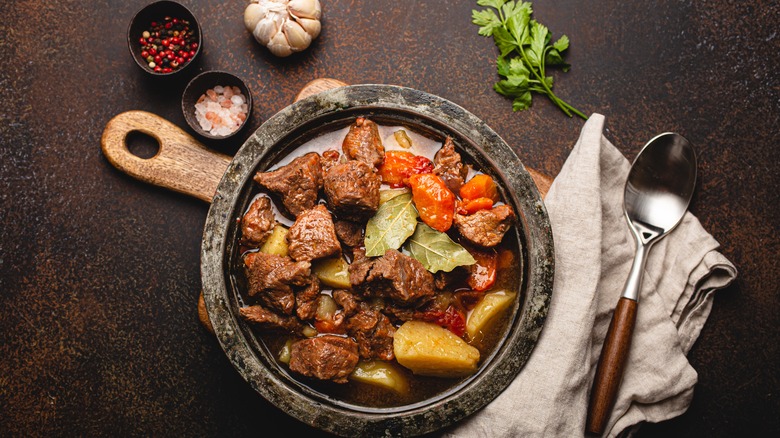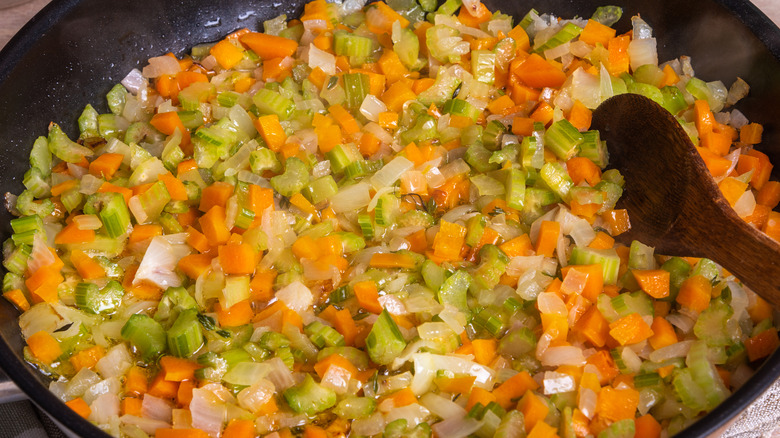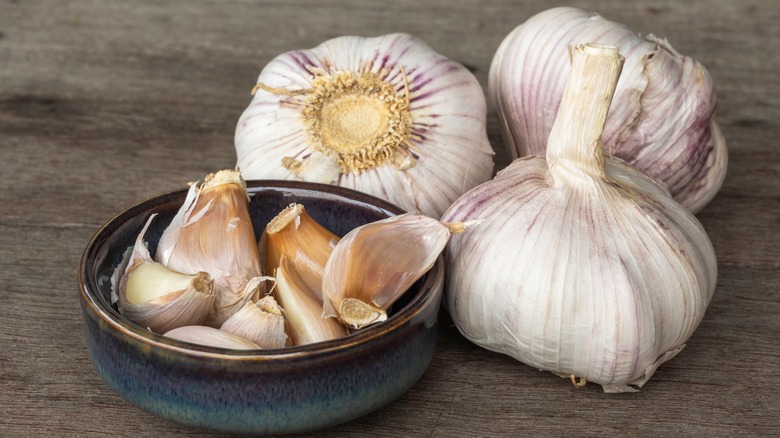Why You Should Always Add Garlic Last With Aromatics
Cooking with garlic can add flavor complexity and depth to any dish. Garlic is often cooked in combination with other aromatic bulbs (such as onions, shallots, and leeks), veggies, herbs, and spices to impart a flavorful base to dishes including stews, soups, and vegetable stocks.
While garlic can be an all-star ingredient for elevating dishes, many home cooks make the mistake of adding it to the pan first to cook with oil or at the same time other veggies are added to the pan. Due to its low water content and the small surface area of minced garlic, however, it has the tendency to burn and char when added into the pan too early, even when cooked at low heat. The result is often blackened bits that not only look unappealing, but also carry bitter, pungent flavor notes. This is because the garlic hasn't had the chance to cook fully and evenly throughout.
Fortunately, there's a solution for this common faux pas. Simply add the garlic last when cooking aromatics. When you wait to add the garlic until the other veggies have begun to cook, the extra moisture from the veggies is released into the pan, providing a hydrated environment for the garlic to cook properly without burning.
When to add garlic to the pan
While cooking garlic can mellow out its pungent flavor, the order in which you add aromatics to the pan is key. It also helps to finely mince garlic instead of chopping in chunks (which carry more concentrated flavor bites). This will better distribute the garlic (and its flavor) throughout the dish. Some chefs even recommend submerging garlic cloves in water or lemon juice to soften its bite prior to mincing and cooking.
Though these techniques help, for optimal garlic flavor, it's crucial to add garlic after the other aromatic veggies have begun to sauté. When preparing a mirepoix (a French cooking term for the veggie foundation of many dishes, such as beef stew) for example, first add butter or oil to the pan. Then, cook the mixture of chopped onions, carrots, and celery over low or medium-low heat for five to 10 minutes, or until the veggies begin to turn soft and translucent (a cooking technique referred to as sweating).
You can add minced garlic during the last 30 seconds to two minutes of sweating your other vegetables, depending on your personal preferences. For a stronger garlic flavor, cook it for a shorter amount of time.
Let garlic's flavor shine through
Though many people are hesitant use garlic because of its strong flavor, cooking garlic takes away the astringent bite that comes with tossing raw garlic into dishes such as hummus, chimichurri, or pesto salad. Simply learning to cook garlic the correct way can open up a world of flavor possibilities in the kitchen. Plus, you won't miss out on all the health benefits associated with garlic, such as lowered blood pressure and cholesterol levels.
Adding garlic to the pan after cooking the other aromatic veggies ensures it gets cooked fully and just enough to accentuate the characteristic savory sulfuric undertones and subtly sweet, caramelized flavors it has to offer. Cooked the right way, garlic will add depth and elevate an array of other flavors.
After adding garlic into the pan to cook, you can also throw in other spices, such as cumin and paprika, to build a flavor base for vegetarian chili. Or, you can add herbs, such as thyme and oregano, for a balance of earthy and savory notes.


